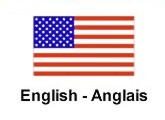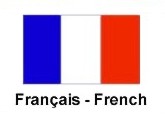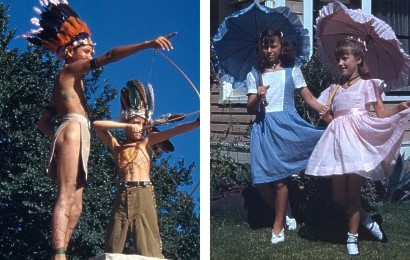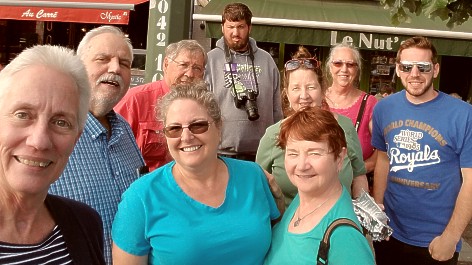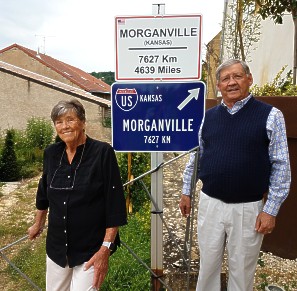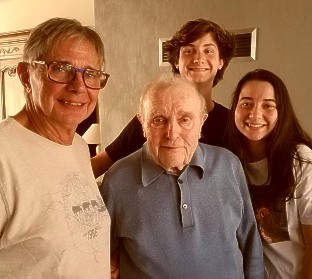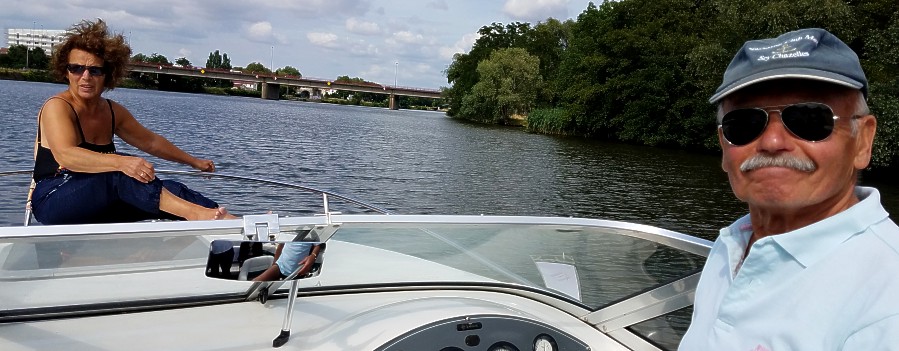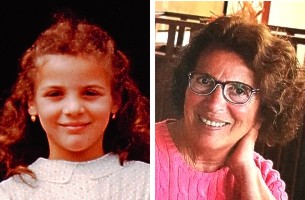Closing the Circle
During the years of researching the sister-city connection, Freeland and Vaughan were often told what an interesting story it
was. Some people suggested they should consider leading a trip to Fèves like the one Gérard arranged in 2015 for people from
France to visit Morganville.
But there was a problem. While Fèves is today a prosperous place, like Morganville, it is still a small village and an extended
stay was not reasonable. Torlotting had faced the same problem when arranging the visit to the small village on the Republican
River. To make the trip worth the expense and time, he had added tours of Washington, D.C. and New York City. So when Vaughan
and Freeland considered serving as guides on a trip to Fèves, they knew visits to nearby destinations would make the trip more
interesting. Metz could serve as the "home away from home."
When the couple proposed such a trip for the summer of 2019, nine people took them up on their offer. Three had direct
connections with Morganville. Jay Mellies had played a Native American in Velma Carson's play. Margretta (Flinner) Fosse
was Carson's niece and had been a Norwegian girl in the pageant. Her son Ben was familiar with the village and the Carson
family.
Photos from the pageant. Left: Mellies with the
bow and arrow; right: Fosse in the pink dress
Louise "Lou" Benjamin and Debra "Deb" Skidmore were university colleagues of Freeland and had watched the rediscovery of the story unfold. Karen (Vaughan) Ethridge and son Josh had heard the tale through Vaughan, her father and his grandfather. Sherri Bowlby, a high school classmate of Freeland, was familiar with her work. Bowlby knew nephew Cody Church, a World War II buff, would enjoy joining them.
On June 12, five arrived in Metz from the United States after landing at Findel airport in Luxembourg City. Three more came by auto from Berlin, Germany. Another rode the train from Switzerland. Vaughan rented a nine-person van at Findel that would transport most of the group for the next two weeks. Ben was unable to arrange a full two-week vacation and so he and his mother did not arrive until late the following day. They used a rental car during their stay.
(l-r) Skidmore, Church, Bowlby and Benjamin waiting at Findel airport
For most of their time in France, the group explored the unique sites and enjoyed the experiences the area had to offer. These included a trip to Trier, Germany and Jouy-aux-Arches, France to see Roman artifacts. An all-afternoon tour of the AS.CO.ME.MO. 1939-1945 museum a few miles from Metz in Hagondange provided a glimpse into what life was like for citizens of Lorraine during the war. A Verdun visit highlighted the devastation of the Great War.
Another adventure was traveling to Bastogne, Belgium to see the World War II museum and have supper in the village. American
Army units had succesfully defended Bastogne during December of 1944 while surrounded by German forces.
The group ate at "Le Nut's" restaurant, named for the Allied commander's "Nuts!" response to the
German surrender demand. (l-r) Freeland, Vaughan, Mellies, K. Ethridge, Church, Benjamin, Skidmore, Bowlby, J. Ethridge
During that excursion, Vaughan and Freeland took Bowlby to the Ardennes American Cemetery and Memorial near Liège, Belgium so she could visit her uncle’s grave. Floyd Hicks was a B-17 airman who had died during a bombing mission in WWII.
Left: During the visit to Remich, Luxembourg, a stop was made along the Moselle River to look at the vineyards on the banks.
Center: After the winery tour, a visit was made to the medieval castle Chateau Malbrouck. Right: (l-r) J. Ethridge, Skidmore, K.
Ethridge and Benjamin outside the chateau
But it was not all about history. Entertaining times included a stop at a candy factory in Verdun, and a concert inside
and light show outside St. Étienne Cathedral in Metz. Francis Pracht led a tour of Luxembourg City and a visit to St.
Martin's winery in Remich, Luxembourg.
The reason for the trip was the connection between the sister cities and Saturday, June 22 was selected for the visit. The
group first gathered in mid-afternoon at the Pracht home in Fèves for drinks. They then moved "up the hill" to see the old
church and remodeled presbytery housing the village mairie.
Then, about 8 p.m. after a second stop for refreshments with the Prachts, they left for the village Social/Cultural
Center for supper. They were directed to take seats at the head table because, in Fèvot Roger Wechtler's words,
"You are the VIPs!"
M. Fosse and Mellies on the southern steps of the Mairie
After introductions, there was a course of appetizers before a dinner of couscous with vegetables, lamb meat, and skewers of
steak and sausages. The wine flowed freely, which also facilitated the flow of conversation across the language barrier. There
was a wide variety of desserts, including cantaloupe, baklava, cake and other delicious items.
Near the end of the evening, several fellows went through those assembled serving the "baby stuff" - champagne - and the "manly
stuff" - Mirabelle. The locals showed the Americans how to party and displayed true hospitality!
After the meal, Alex Dentice (left) served the "manly stuff" - Mirabelle - while K. Ethridge reacts to a sample and B. Fosse enjoys her
reaction. J. Ethridge is at his left in front of Benjamin. Skidmore (black top with white dots) speaks with Church. M. Fosse sits
behind them. The many wine bottles and glasses for wine and champagne on the table are one sign a good time was had by all.
The party broke up as midnight neared. The Fosses had a flight home the next morning and so it was necessary to say "Bonne nuit"
and "Au revoir" to them.
The following Wednesday, Freeland and Vaughan took their seven remaining guests to the airport in Luxembourg City for their
flights home.
But Vaughan and Freeland were not yet ready to leave. After a few days visiting with friends in Berlin, the couple
returned to Metz on July 9.
The following day, during a visit to the Torlotting home, they met Gérard's uncle René Torlotting. Like his brother Henri,
he had also been a school teacher. Despite being in his 90s, he was sharp of mind and shared a number of stories about
the family and his years of teaching. Gérard’s daughter Sandrine, Hervé's children Paul and Emma, Hervé’s wife Christine,
and the Prachts completed the group who gathered at the table for lunch that day.
(l-r) Gérard, René, Paul and Emma Torlotting
Over the years, Vaughan had spoken with friends in England about the sister cities. Courtney Wall, the granddaughter of one of
these friends, joined Freeland and Vaughan the day after meeting René. Like the June visitors, she wanted to see the area
and the village. But the three had no idea they would soon be the guests of the Lagrange family on a boat trip on the Moselle.
That trip could be traced back to another visit in 1949.
Billie (Pierson) Utley was the first person from Morganville to visit Fèves. Before they left their home in Paris in 1949, her
amateur-photographer husband Ed had acquired some new color film and was eager to try it. Youngsters Liane Dorrwachter and her
cousin Gabrielle Gaspard caught Ed's eye as they stood in the doorway of a Fèves home. They were two of the village children who
had convinced the people of Morganville to move forward with their plan to help their French sister.
Vaughan had hoped for some time to meet Liane and Gabrielle. But Torlotting had informed him that both Gabrielle and her
husband Maurice had died a few years earlier. However, Vaughan located Liane and they had connected in April, just two
months prior to the June trip. They had met in person at the concert in St. Étienne Cathedral in June and then again
with her daughter Virginie during an afternoon in Metz.
Gabrielle (Gaspard) Neveux as a youngster and as a grandmother
An interesting detail emerged during the initial discussions with Liane and husband Pierre Lagrange. It was learned that for many years they owned a sewing shop on Boulevard Saint Symphorien. It was located a short distance from the home Freeland and Vaughan rented, and one of the shop's suppliers had been the Torlottings' business in central Metz.
With Liane on the bow and husband Pierre at the wheel, Vaughan, Freeland, Wall and the Lagrange's
daughter Virginie went for a Moselle boat ride.
On July 13, Liane and Pierre invited Freeland, Vaughan and Wall on a Moselle cruise on their boat to the heart of Metz and
then some distance upriver. After, they had supper at their daughter Virginie's and her husband Pierre’s home in Scy-Chazelle.
Virginie and Pierre's daughter joined them.
On July 17, a larger group gathered for supper at the Lagrange home in Longeville-les-Metz. Guests included daughter Virginie,
Gérard, Solange and their granddaughter Emma Torlotting, Freeland, Vaughan, Wall and two of the Lagrange grandchildren.
Liane (Dorrwachter) Lagrange as a youngster and as a grandmother
While Vaughan and Freeland's time in Europe was quickly drawing to a close, they planned a repeat visit to Trier so Wall could see some of the things the earlier visitors had experienced. But it was discovered that although Paul and Emma had visited their grandparents in Fèves for years and had accompanied them on many trips in Europe, neither of them had ever visited the German city. Paul was unable to go along as he was with friends in Paris, but Emma joined the other three.
On the evening of July 18, Wall flew home to England. During the next few days, Freeland and Vaughan attended some concerts in
Metz and did a little shopping. They completed their visit by having lunch with the Prachts at a Chinese restaurant in Fèves.
On the 23rd, they headed home from Findel airport.
Freeland, Wall and E. Torlotting in the
royal residence garden in Trier, Germany
More than six years had passed since the three journalism students had unearthed the story of the sister cities. Many, such as Haney, the Torlottings and Prachts, had contributed much time and effort into reassembling what had happened so many decades before. What remained was for Freeland and Vaughan to put the story in a form that would allow it to be easily experienced by future generations.
